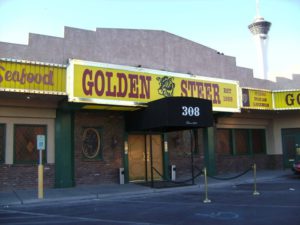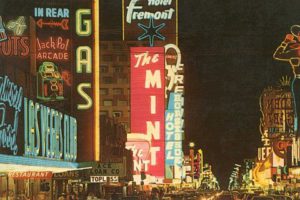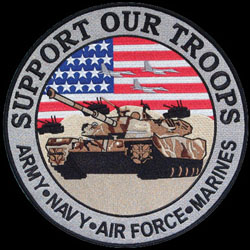In a car culture like ours, certain roads and highways, from Broadway in New York City to Sunset Boulevard in Los Angeles, are significant reference points for a large number of people.
Less known, but of interest to those intrigued by Las Vegas and its mob past, is a short stretch of Sahara Avenue in Sin City arguably packed with as much high-profile Mafia history as any geographically compact space in the country.
In the mile or so from the Golden Steer Steakhouse at 308 W. Sahara Ave. to the Tower of Jewels at 896 E. Sahara Ave. are:
• The site of mob enforcer Tony Spilotro’s now-demolished jewelry store.
• The parking lot where oddsmaker Frank “Lefty” Rosenthal’s car was blown up, injuring him.
• The jewelry store where authorities nabbed the mob-connected Hole in the Wall Gang during an attempted break-in.
For those wanting to take in these sites, the drive time is only a couple of minutes, if the traffic light is green at the intersection of Sahara and the Las Vegas Strip.
The Strip divides Sahara into west and east portions.
According to Google Maps, which puts the distance from the Golden Steer to the Tower of Jewels at about a mile, you can walk the whole stretch in a little more than 20 minutes.
Being close to downtown, Sahara has always been an important cross street, but in the 1970s and ’80s, when mobsters were generating headlines in town, the Las Vegas Valley was a lot less spread out. That makes it easier these days for those wanting to get a look at the sites associated  with that crime-infused era.
with that crime-infused era.
One starting point on the self-guided tour is the Golden Steer, a landmark Las Vegas restaurant on West Sahara near the Strip.
The Golden Steer’s website notes that it has been in business since 1958, hosting an all-star roster of celebrities, including Frank Sinatra, Elvis Presley and Muhammad Ali.
The Golden Steer also is the site where Tony Spilotro, the Chicago Outfit’s enforcer in Las Vegas, initially sat down around 1979 with newly arrived Frank Cullotta to deliver a set of marching orders.
Spilotro had been in town since 1971. He and Cullotta were childhood friends in Chicago.
In Las Vegas, the two ate at the Golden Steer that first night, walking the short distance from the jewelry store, Gold Rush Ltd., where Spilotro and his associates dealt in stolen gems and jewelry.
In his memoir, “Hole in the Wall Gang In My Own Words,” written with author Dennis N. Griffin, Cullotta recounts the episode in which Spilotro, over a 6 p.m. dinner at the Golden Steer, informed him that his duties would include putting together a crew to extract a street tax from freelance drug dealers and bookies.
Additionally, Cullotta was to keep an eye on Frank “Lefty” Rosenthal, an oddsmaker running several casinos, but most prominently the Stardust hotel-casino on the Strip, for the Chicago Outfit.
State regulators in 1978 had placed Spilotro’s name in the gaming Black Book of undesirables, banning him from entering the Stardust or any other Nevada casino. Cullotta could still go in, however.
Rosenthal was overseeing the illegal skim of untaxed casino winnings, with tens of thousands of dollars each month going back secretly to Midwestern mob bosses, but some were concerned that his notoriety was drawing too much heat, threatening to dry up the cash pipeline.
“He’s an arrogant son of a bitch,” Spilotro told Cullotta over dinner, “and I don’t like him.”
To earn money, the crew would be allowed to steal from around town, if they slipped Spilotro 10-20 percent of any haul over about $5,000. They could keep every penny of their scores under that amount.
As the news stories piled up, the crew would be dubbed the Hole in the Wall Gang for their tactic of knocking a hole in a wall or roof to enter any place they wanted to burglarize.
An iPhone video that I shot two years ago and posted on my YouTube channel shows the area where the Gold Rush was located, about where the high-rise condominium complex can be seen at the far end of the empty space. After I shot the video, the Lucky Dragon hotel-casino was constructed in that vacant lot. The Golden Steer is visible at the conclusion of the brief video.
A short distance east of the Golden Steer, across the Strip, is the parking lot where Rosenthal, leaving Tony Roma’s restaurant with a take-out order of ribs one October night in 1982, was injured when his car blew up.
Another video I shot, also now on my YouTube channel, shows the parking lot and the lamppost in the middle of the lot near where Rosenthal’s car was parked. The shuttered Tony Roma’s restaurant seen in my video has been converted into a Hustler Hollywood adult store.
A factory-installed metal balancing plate in Rosenthal’s 1981 Cadillac Eldorado deflected the bomb blast away from him as he was starting the car, sparing his life, according to published accounts.
No culprit was ever arrested for the car explosion, though some considered Spilotro, who had been involved sexually with Rosenthal’s wife, to be the prime suspect.
The love triangle involving those three became the basis of the 1995 hit movie “Casino.” All three have been dead for years now.
A brief walk from the parking lot is the Tower of Jewels, which was called Bertha’s when Spilotro was in town.
Bertha’s is where law enforcement authorities, tipped by an insider, captured Cullotta’s Hole in the Wall Gang attempting to go through the roof on a Saturday night to get at the store’s vault and jewels, hoping for a $1 million haul.
Spilotro had approved the break-in but wasn’t with the gang on that July 4 night in 1981.
A video I shot in 2015, showing the Tower of Jewels across the street from where I was parked, is on my YouTube channel.
The arrest was the beginning of the end for that whole bunch. Cullotta, fearing that an increasingly erratic Spilotro would have him killed, became a government witness.
For a time, Cullotta entered the federal protection program, but now, closing in on age 80, he is conducting a mob tour of the real-life Las Vegas sites portrayed in “Casino,” the fictionalized movie version of those former dark days.
Cullotta is one of the few remaining figures in town who can point to a mob-related location, like some of the well-known sites in that compact stretch of Sahara Avenue, and say exactly what happened, because, if he wasn’t there, he at least was very familiar with those who were.
Larry Henry’s YouTube channel includes videos he shot of mob sites in Las Vegas, the apartment building in Santa Monica, California, where Whitey Bulger was arrested, and the remote Arkansas airport where Barry Seal transported drugs into the U.S for the Medellin Cartel. Subscribe HERE.

 July 21st, 2017
July 21st, 2017  CEO
CEO 
 Posted in
Posted in  Tags:
Tags: 



